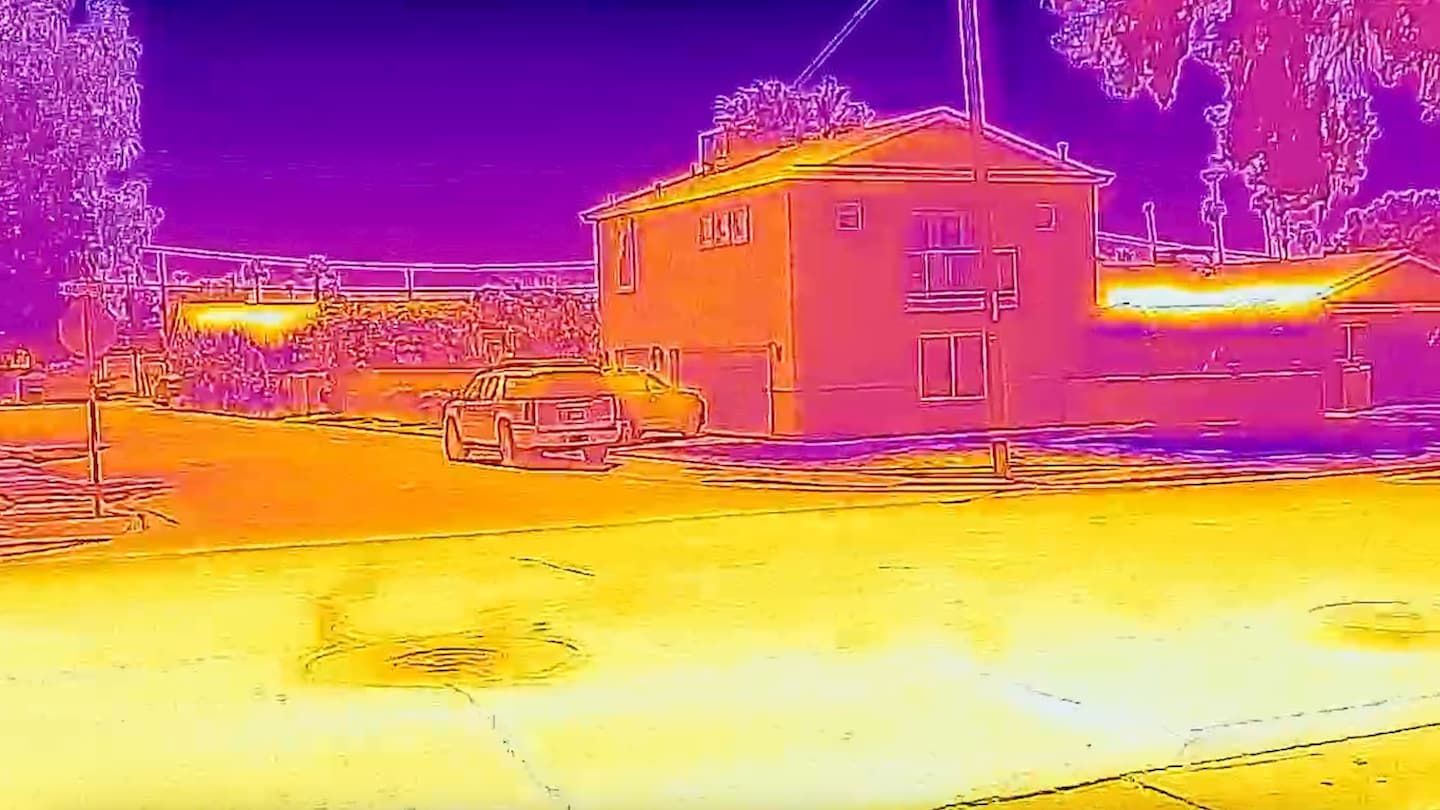Amid Phoenix's heat wave, see how cooling technology helps
Climate Solutions These thermal images show how Phoenix uses technology to keep cool A thermal image of a playground in Phoenix on July 20. In 2021, the city became the first U.S. city with a publicly funded office dedicated to managing extreme heat. We took an infrared camera around the city to see how some of its measures are faring in the middle of this historic hot streak. (Erin Patrick O'Connor/The Washington Post)
Listen 8 min Comment on this story Comment Gift Article Share
PHOENIX — A record-breaking heat wave has been baking much of the sprawling metropolitan area here for at least three weeks — but some parts of the desert city aren’t getting quite as hot. Take a wide road in a residential neighborhood northeast of downtown that has been treated with a coating designed to better reflect the sun.
Through the lens of an infrared camera, an adjacent street paved with traditional dark asphalt glows bright yellow with an average surface temperature of about 154 degrees Fahrenheit. The treated road appears orange, indicating a cooler average temperature reading of 130 degrees.
(Video: The Washington Post)
That’s still scorching, but in urban areas where pavement and buildings can trap heat and make rising temperatures feel hotter, even small differences in degrees can help a city better withstand the extreme weather.
“With the deployment of cool surfaces and smart technology, we can at least offset some of the urban heat effect, if not fully offset it, moving forward,” said David Hondula, director of the city’s Office of Heat Response and Mitigation.
Advertisement
The massive heat dome that has smothered the southern United States in recent weeks is shaping up to be one of the most intense tests so far for cities that have been preparing to endure what experts say will be harsher summers. Last week, the mayors of Atlanta; Boston; Columbia, S.C.; Dallas; and New Orleans announced plans to cool their cities using a combination of approaches, including reflective roofs and trees, as part of broader efforts to mitigate the effects of climate change.
Phoenix, where summer temperatures regularly hit triple digits, has already made some strides. In 2021, it became the first U.S. city with a publicly funded office dedicated to managing extreme heat. We took an infrared camera around the city to see how some of its measures are faring in the middle of this historic hot streak. The images provide readings on surface temperature, which is one metric used to assess heat impacts.
Here’s a look at how much of a difference the measures can make.
Cool pavement and roofs
The coating that lowered the surface temperature of the neighborhood street in the video above is known as cool pavement.
The light-colored seal is designed to reflect sunlight so the surfaces it’s applied on absorb less heat than standard pavement. The idea is to help reduce urban heat, lower energy consumption and make the city’s infrastructure more resilient to heat.
The water-based asphalt treatment, which is two to three times more expensive than the standard seal, is applied on top of existing pavement, said Kini Knudson, director of the city’s Street Transportation Department. The city plans to eventually treat its 4,000 miles of residential roads. So far, it has coated about 100 miles.
Our infrared readings roughly align with what research into cool pavement has found. Roads treated with it had an average surface temperature of 10.5 to 12 degrees Fahrenheit lower than traditional asphalt during the hottest parts of the day, according to a study conducted by researchers at Arizona State University in partnership with the city. The coating kept temperatures below the surface of the streets cooler, as well, which could better protect pavement from heat’s wear and tear and help save taxpayer dollars, experts said.
Advertisement
Cool pavement could also lower air temperature — the measure most often used to report the weather — by about half a degree, said David Sailor, director of the School of Geographical Sciences and Urban Planning at ASU, who studies ways to lessen the urban heat island effect.
“You and I probably can’t tell the difference between 110 and 110.5,” Sailor said. “It’s hot.”
But spread across the city, that reduction in temperature could be enough to scale down the use of air conditioning and water, Sailor said. Using some back of the envelope calculations, he estimated cooling the entire city by 0.5 degrees could lead to more than $40 million in energy savings for the greater Phoenix metro area, and save up to 500 million gallons of water in the summer.
There are limits to where cool pavement can be applied. Because the treated pavement reflects the sun’s rays, it could feel 5.5 degrees warmer to a person walking down the middle of street during the hottest part of the day, research shows, so it probably shouldn’t be used in places with high foot traffic, such as plazas and playgrounds. And it probably won’t be as effective on streets that are heavily shaded by trees.
Large parking lots, though, could be ideal, Sailor said. Roofs, which can reach temperatures of 150 degrees or more on a sunny summer afternoon, can be another prime location for a reflective surface.
“Cool roofs are a wonderful solution,” Sailor said. “It frustrates me when I see people with black roofs in Phoenix.”
Cooling shade
Researchers are also testing other kinds of reflective coatings that cool the air and help reduce the greenhouse effect by sending heat out of the atmosphere.
At a local dog park in south Phoenix, ASU researchers are testing an advanced film made by 3M on a ramada, an open-air shaded structure that gets its name from “rama,” or “branch” in Spanish. The coating can reflect the sun’s heat and quickly shed it, Sailor said. That means the material can stay cooler than the temperature of the surrounding air.
In infrared images, much of the treated metal roof appears purple. The top of a nearby shade structure with a beige fabric roof in the same park shows up as a hotter red-orange color.
(Video: The Washington Post)
The preliminary results from the research, a collaboration between ASU, 3M and the city, suggests that while an untreated roof heats the surrounding air, the film can have a cooling effect.
“That, in my mind, is a game changer, because then you’re putting in surfaces that are actively cooling the urban environment instead of just warming it less so,” Sailor said.
Once it’s developed, the product could be applied on buildings or bus stop shelters and other shade structures that can provide relief from the heat for people who are outdoors.
Access to shade at the dog park is one reason Molly Green said she has continued to stop by once or twice a week with Devi, her 6-year-old American Staffordshire terrier, despite the heat.
Without the shade, “I probably would come just less frequently,” said Green, 27, on a recent scorching July day when the temperature was 104 degrees. “Or, I would have to completely move around my day.”
Shade in the park
Even regular shade can make a big difference by blocking the sun and reducing the surface temperature of the ground, which changes how much heat is hitting our bodies, said Jennifer Vanos, an ASU professor in the School of Sustainability who researches extreme heat and thermal comfort.
“When you think about the easiest way to reduce that radiant heat load when you’re outside in a place like Phoenix, it’s through shade,” Vanos said.
Advertisement
In infrared images, the ground underneath these structures was on average about 17 degrees cooler than an unshaded area nearby.
(Video: The Washington Post)
But given the blistering heat Phoenix regularly endures, solutions such as shade and cool surfaces can only help so much. They can also be expensive and complicated to implement.
“Despite what we do, Phoenix is a hot city in a desert climate,” Sailor said. “It’s going to remain hot, so how do we protect our citizens on the hottest of days?”
Advertisement
When asked that question, residents of the Edison-Eastlake neighborhood said that in addition to more shade, a working water feature in the park would help, said Eva Olivas, executive director and CEO of the Phoenix Revitalization Corporation, a nonprofit group that worked with the community to help improve the park.
“In Arizona, you can get heat stroke so fast,” Olivas said.
Infrared images of the park’s splash pad, which shoots water from various spouts set in the ground, showed the average surface temperature of wet areas was nearly 50 degrees cooler than spots where the water didn’t reach.
(Video: The Washington Post)
As the temperature crept toward 100 degrees last week, two Phoenix residents cooled off on the splash pad, drenching their clothes and bodies in the refreshing streams.
“At a 115, 100 degrees, this is all you need,” one of the residents said as he reclined shirtless on a shaded bench near the pad. “It feels like 80 now.”
Source: The Washington Post


